Community by the Numbers, Part II: Personal Circles
byIn my previous post, I talked about the limits on sizes of tightly-knit communities. These group limits are closely related to a number of interesting personal limits, and are often confused with them.
Unlike the group limits, personal limits actually measure something different: the number of connections that an individual can hold. They're yet another thing that you must consider when thinking about communities of people.
Personal Limits
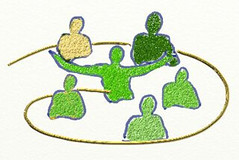 The Support Circle: This is the number of individuals that you seek advice, support, or help from in times of severe emotional or financial stress. In most societies, the average size of an individual's Support Circle is 3-5. The people are the core of your intimate social network and most typically are also kin. In sociology papers this is often called the "support clique".
The Support Circle: This is the number of individuals that you seek advice, support, or help from in times of severe emotional or financial stress. In most societies, the average size of an individual's Support Circle is 3-5. The people are the core of your intimate social network and most typically are also kin. In sociology papers this is often called the "support clique".
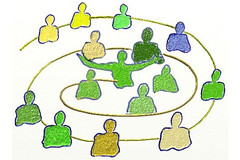 The Sympathy Circle: This is larger then the Support Circle — it is the number of people that you go to for sympathy and also those people whose death would be devastating to you. The Sympathy Circle typically is in the range of 10-15 people, but can vary widely from as few as 7 to as many as 20. The Sympathy Circle often may be made up of kin, but usually includes some peers as well.
The Sympathy Circle: This is larger then the Support Circle — it is the number of people that you go to for sympathy and also those people whose death would be devastating to you. The Sympathy Circle typically is in the range of 10-15 people, but can vary widely from as few as 7 to as many as 20. The Sympathy Circle often may be made up of kin, but usually includes some peers as well.
In sociology papers the Sympathy Circle is also known as a "sympathy group", but I wanted to avoid the term "group", as it is implies that all the members of a Sympathy Circle are connected. Instead, members of your Sympathy Circle will have additional people in their own Sympathy Circles that are not part of your own.
An interesting issue with the Sympathy Circle is that as a personal limit, 10-15 is a typical size. however, if you bring them all together in one place, they will likely become a Judas-Number-sized group, with all of the problems associated with that size.
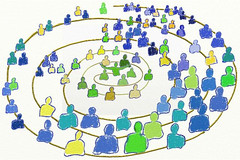 The Trust Circle: These are the people that you have some type of intimate connection to. One study measured it as the people that you would send a family Christmas card to, while another simply tested emotional closeness.
The Trust Circle: These are the people that you have some type of intimate connection to. One study measured it as the people that you would send a family Christmas card to, while another simply tested emotional closeness.
In pre-Friendster days the Trust Circle would be those people that you considered your "friends", however today the meaning of that term has begun to change. In my own usage, your Trust Circle are people that you have strong ties to and that in some measure you can trust. I have also called the Trust Circle your personal "intimate social network".
The size of different individuals' Trust Circles can vary widely (40-200), but some studies show that the mean is on the low side of 150. This has led a number of researchers to compare this number with the Exclusive Dunbar Number of 150. However, I believe that this is a mistake; they are related, but in today's society members of your Trust Circle are rarely in the same mutual group.
The Emotional Circle
I personally define your Emotional Circle as the total number of people that you can have some type of non-mutual emotional connection with, most likely spread across numerous groups of all sorts. You "like" them in some way, but do not necessarily have to have strong ties to them.
In academia this threshold is called "social channel capacity". A study using two different methods to estimate, both suggest that it falls right around 290. However, I like to describe this number as "just short of 300." As I wrote in Dunbar Triage, many people confuse this number with the Dunbar Number (and in fact I have in some of my older pieces). However, like the Trust Circle, it's a distinct entity.
Emotional Circle size can vary quite a bit from individual to individual. Some people might have half the average capacity, and others considerably more — which is much more variation than you see among the sizes of smaller personal thresholds.
Some of those variations are individual, but some are societal. As I wrote in Cheers: Belongingness and Para-Social Relationships, I believe that our modern era of television causes us to create para-social relationships with imaginary characters who we nonetheless become emotionally involved with, and thus might reduce our social channel capacity.
Is our Emotional Circle smaller today because of TV or is it higher because online communities can help to remind us of our emotional connections to other people? That's a topic that probably deserves more study.
An interesting point to make is that the people who are in your Emotional Circle, but are not in your Trust Circle, are your "weak ties" in social network terms. What is important about weak ties is that studies show (pdf) that opportunities and knowledge flow to you much more through weak ties than through the more insular strong ties of your trust circle.
The Familiar Stranger
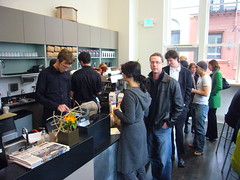 Outside of our Emotional Circle is a larger, more tenuous circle: those people whose faces you recognize, but who you know nothing more about. These are your "Familiar Strangers".
Outside of our Emotional Circle is a larger, more tenuous circle: those people whose faces you recognize, but who you know nothing more about. These are your "Familiar Strangers".
Studies show that the percentage of familiar strangers in your vicinity has a real impact on your willingness to take risks. If you are in a new place with no one that you recognize, you'll avoid eye contact and will generally be unwilling to approach strangers. In a place where there are a lot of people that you've seen before (say in your favorite cafe, at a conference, or in the lunchroom of a large company), you'll be much more willing to take risks, such as asking questions, or sitting down next to someone to eat lunch.
I haven't been able to find any studies to show how many people that we can recognize, but for some people it is much larger than the number of people in your Emotional Circle, probably well over a thousand. However, there is also a lot more variance: some people are face-blind or near face-blind, and have a difficult time even recognizing friends.
There could also be some interesting research looking more closely at social network software. I find it fascinating that the professionally-oriented social network LinkedIn resisted supporting photos in profiles for so long yet ultimately failed, as well as how other social network software companies have attempted to require "real" photos of people rather then allowing "fakesters" or avatars.
Crossing the Circles
I've used the term "circles" throughout this article because it's a great metaphor for these levels of personal involvement. They can literally be thought of as concentric circles of people getting further and further away from an individual.
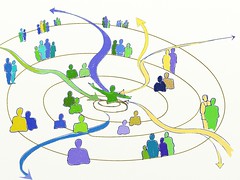 However, if you want to consider them with an even more graphic bent, think of these circles as the ridge lines of a topographical map. An individual sits at the center, and around him lie many other people, fading slowly away as the distance increases.
However, if you want to consider them with an even more graphic bent, think of these circles as the ridge lines of a topographical map. An individual sits at the center, and around him lie many other people, fading slowly away as the distance increases.
Winding through these topographical lines, like forests or rivers, are geographies of physical and emotional connection.
Kin are one of the most interesting geographies, because they lie all across the map. There's a clump of them in the innermost circles, but there are also many who lie in the realm of Familiar Strangers, including those cousins and great-aunts who you only see at family gatherings, and whom you know nothing about.
There are also forces being exerted upon the circles, acting like gravity to draw people together. They are the forces of trust, influence, and more. Their pulls are greatest toward the center, across your Circles of Support and Sympathy, but as people move farther away, these forces drop off quickly.
Thus, though I've described them as circles, with strict boundaries, we should also see these personal connections as fluid entities, a regular ecosytem of personal community.Conclusion
Whereas the group thresholds that I discussed in my last article define the limits placed on community group size, the personal limits described herein instead define the limits placed on how many people an individual can know with various degrees of intimacy.
Perhaps there are societies where these two things might be the same. A true survival community might contain everyone a person knows, and thus he could draw out all his personal circles across that community canvas. However, in our modern era they're much more likely to be distinct, with an individual interacting with the members of his circles of acquaintances through numerous different group communities.
With this bifurcation of personal and group community limits, we have to briefly stop and ask a few questions. How do they relate? What can personal limits tell us about efficient community creation? Does founding a group upon a personal circle make its growth easier or harder? Conversely, what type of communities lead naturally to the creation of intimate circles?
Herein I've simply outlined personal thresholds as a contrast to group thresholds. The exploration of how these limits interact is worthy of additional studies.In my next article "Community by the Numbers, Part III: Power Laws", I will talk about how both group thresholds and personal thresholds have a role in larger, less tightly-knit groups.
Some other posts about the Dunbar Number and group size issues:
- 2004-03: The Dunbar Number as a Limit to Group Sizes
(also some really good comments)- 2005-02: Dunbar Triage: Too Many Connections
- 2005-03: Dunbar, Altruistic Punishment, and Meta-Moderation
- 2005-07: Cheers: Belongingness and Para-Social Relationships
- 2005-08: Dunbar & World of Warcraft
- 2005-10: Dunbar Number & Group Cohesion
- 2008-09: Community by the Numbers, Part One: Group Thresholds
My bookmarks to various papers and websites on this topic are available at delicious.com/ChristopherA under some of the following tags:
- personal circles - everything I have on the topic.
- familiar strangers - those people you recognize by face.
If you have any links on this topic that you would like to share with me, tag them for:ChristopherA and I'll take a look.
Illustrations by Nancy Margulies, photo by davitydave. Many thanks to Shannon Appecline and F. Randall Farmer for their assistance with this series.